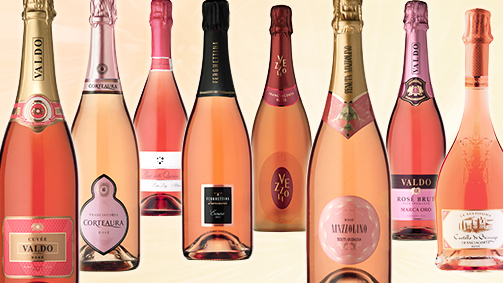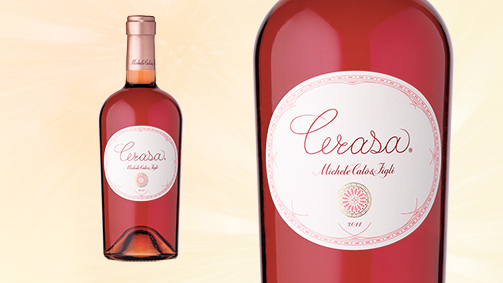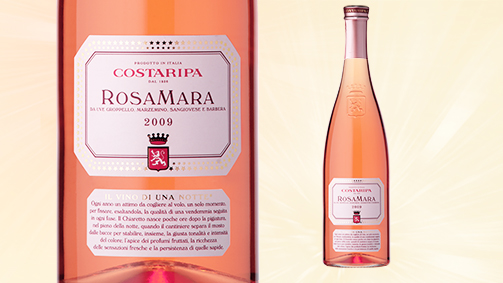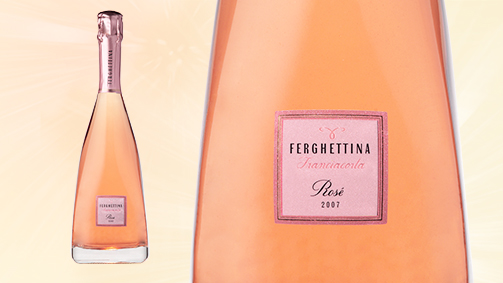Rosé & Rosato: not just a wine but a way of life

“Apart from people, only wines can really tell us their stories by making great statements that echo down the centuries, so that they come before us today with their identity documents intact”. So says Veronelli (source: “Luigi Veronelli. Life is too short to drink bad wines” by Nichi Stefi and Arturo Rota, p.300).
In this complex identity, the colour of the wine is the visual lure that fascinates and stimulates, attracts and intrigues.
Pink, in its infinite varieties ranging from warm coral to golden, is not the colour of a single wine but of two enchanting universes: Rosé and Rosato.
By Rosato, we mean the wines of central and southern Italy, the most famous being the wines of Salento. Rosé refers the wines of the north that can be still or sparkling. Wines of freshness, immediacy and uniqueness. These are traits that make them not only pleasurable, but a scintillating accompaniment to convivial occasions. They usually accompany lunch and dinner starters, including on important occasions, and emphasise the taste of healthy Mediterranean dishes.
It is the Rosato wines that bring in new consumers every year: palates not schooled in the complexity of wines can gradually discover this universe, starting with the Rosato wines, which offer tangible satisfaction in taste and stimulate the discovery of more complex sensory experiences by training their palates, a development that only occurs if quality Rosé wines are chosen.

Let us go to a windswept land between two seas, the Ionian and the Adriatic, to access a world where time has the slow rhythm of the estates that produce noble, sweet grapes like Negroamaro, which is used to produce the Riserva Cerasa of the cellars of Michele Calò e figli. Fernando and Giovanni Calò tell us how they decided to take on the challenge: “The Mjere is our classic Rosato, then last year we decided to produce a Reserve, the Cerasa. The procedure is the classic “teardrop” one: about 100 quintals of Negroamaro selected grapes in the temperature-controlled tank, a 12/15 hours break on grape’s skins, this is the right time to obtain pink coral colour and a balanced taste, rich in flavour. The heavy weight of grapes blows up the grapes naturally, the liquid part falls to the bottom of the tank, meanwhile the solid part, the skins, moves on the top ( it was also called vinification “raising the hat”).
During the racking of the 100 quintals of grapes, we obtain only 30/35 quintals of rosato must flower, a spontaneous product without any pressing, with a wonderful colour, bright such as when we put it in the bottle.
Rosato like the colour of Salento”.
“It was a challenge,” continued Fernando, “because we had our established market, we did not know how it would react to a new product. We worked a lot on the product’s image, on the label. We needed to communicate the novelty but also give a foretaste of the sensations the wine produces, so the artwork is very precise, almost classical but very personal and harmonious. The market is ready, it wants novelty, surprise and we wanted to surprise it. There are 10,000 bottles, intended for those who know how to appreciate a good Rosato, those who know our Mjere well. We are very satisfied with the positioning achieved and the response of the market.”

“The Rosés are wines of the Alpine range, they are less alcoholic, more acidic, very fresh, very tasty, and are extremely clear in colour,” says Mattia Vezzola of Costaripa about the wines of this chosen area, Valtenesi, on the shores of Lake Garda.
“The most northerly point where citrus fruit is cultivated, where there are capers, olives, the cedar trees (Tassoni is from Salò) which are cultivated in 3 places in the world: Lebanon, Calabria, here at Lake Garda, a part of the Mediterranean close to the foothills of the Alps.”
The climate makes this land special. “A unique climate,” says Mattia, well versed on the subject, “extremely temperate, a quality/propensity that comes from the size of Garda: 370 square kilometres, a square centimetre of water gives rise to around 1,400,000 hectolitres of water, the minimum winter temperature is 7°.”
This land has always produced wine. “The great step was taken in 1896 when a Venetian senator, a certain Pompeo Gherardi Molmenti, married a very rich lady of Salò, Amelia Brunati, whose dowry was a splendid villa with 15 hectares running down to the lake. He journeyed to Bordeaux and fell in love with that wine, hired two wine experts and took them to Moniga where the terrain is gravelly, yellow clay and the climate is Mediterranean. It may be called Moniga, but it could call itself Saint Tropez, they thought: this is the land of rosé and, in 1896, the first rosé, the first label was produced in 1904.
“Since then we have cultivated only Italian vines: Groppello, Marzemino, Sangiovese and Barbera. Groppello is one of the rarest grapes in the world, there are only 500 hectares there. In the eighteenth century, it was also found in Val di Non a Massacara then, gradually, it retreated and found its ideal environment on the lake. Barbera and Sangiovese are the two most common vines in Italy among the DOC wines, so Rosé is a typical Italian wine.”
“Our Rosé is a wine that can accompany any spicy dish - wherever there are anchovies, capers, rosemary, sage, tomato, basil and peppers. It can also be drunk fresh and, usually, this type of wine, this type of food, this type of climate is only found where there are extremely moderate people and so Rosé is not just a wine but a way of life.”
“A high technology wine, Rosé is a silky delicacy, a very sophisticated cashmere, you have to know how to work it, how to treat it. It requires great respect, contrary to what is thought of Rosé, which are regarded as the “waste product” of wines, of secondary quality. Companies produce them because they are trendy, Rosé is in demand, sales are on the rise.”
“I recommend to all consumers to approach Rosé by tasting only wines of protected origin, above all Valtenesi. We are sliding, because of our own negligence, towards a low profile but we, in Valtenesi, me in particular, are making great efforts to raise the submerged bows of this ship to navigate by riding the waves. The choice of producing Rosé of quality is rewarding, both for the producer and the consumer. A stinking, pink-coloured tsunami is heading our way, and the choice of high quality is the best way to stand out, investing resources and expertise, enabling a positioning that the Italian and better educated foreign markets will amply repay.

Laura Gatti of the Ferghettina company takes us to Franciacorta, land of prestigious sparkling wines, and surprises us by declaring, without mincing her words, that she loves Pinot Noir and so the unconditional love for their Rosé - 100% Pinot Noir - is its pinnacle.
“Anything but easy, anything but aimed at those who want something light and undemanding,” begins Laura, an introduction that roots us to the spot, listening to her, waiting for her to answer our silent question: why? “To understand this type of wine: our rules lay down a minimum of 25% Pinot Noir, so one could be made with 25% Pinot Noir and 75% Chardonnay. When we decided to produce a rosé we wanted something very different, because otherwise it wouldn’t make any sense to produce it. Over time, we passed from a few bottles to an ever greater number, never too many, today it stands at 30,000, depending on the availability of Pinot Noir, in order to keep the identity pure and because the aim was to unite the structure, the force, the varietal aspect of a red berry with the elegance of a sparkling wine. Pleasing nectar, drinkable but with quite a sharp personality.”
The mind can only conjure up a champagne, the Cuvée Rosé Laurent Perrier, also 100% Pinto Nero, the Rosé par excellence. Laura smiles, pleased at this comparison, and immediately makes clear that the two products have different “callings”.
Why anything but easy? “It was a little difficult at the beginning, there were softer rosés on the market, more appealing, undemanding. To explain, to make our idea of a good product understood, we had to be strategic, precise, in our communication, in the image of the product. Now they ask for it, because it is a different product, the taste is rewarding.”
The future? “It has found its home in a niche slot. It is a wine that not only accompanies but exalts fish dishes, meat like culatello or crudités and seared fillets, with a distinct taste. We wanted our Rosé to be very varietal, displaying notes of berries, raspberries, cherries in alcohol, very typical of the variety, that it be persistent, full-bodied without losing sight of one of the characteristics of sparkling wines, their drinkability. Other producers are trying to follow this course but we have already created and positioned a unique product: it has the acidic freshness of sparkling wines, at the same time it can accompany a meal of several courses without problem… we are always trying to make it more distinct, as is well known. The attention to detail, in defining the image of the product, the label and the communication, enables us to capitalise on the present and future of this Rosé as a tangible value.”
Tag Packaging


